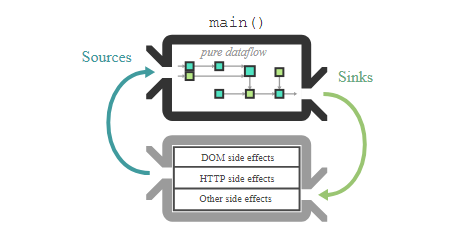Cycle.js is a functional and reactive JavaScript framework for writing predictable code. The apps built with Cycle.js consist of pure functions, which means it only takes inputs and generates predictable outputs, without performing any I/O effects.
What is the basic concept behind Cycle.js?
Cycle.js considers your application as a pure main() function. It takes inputs that are read effects (sources) from the external world and gives outputs that are write effects (sinks) to affect the external world. Drivers like plugins that handle DOM effects, HTTP effects, etc are responsible for managing these I/O effects in the external world.

The main() is built using Reactive Programming primitives that maximize separation of concerns and provides a fully declarative way of organizing your code. The dataflow in your app is clearly visible in the code, making it readable and traceable.
Here are some of its properties:
Functional and reactive
As Cycle.js is functional and reactive, it allows developers to write predictable and separated code. Its building blocks are reactive streams from libraries like RxJS, xstream or Most.js. These greatly simplify code related to events, asynchrony, and errors. This application structure also separates concerns as all dynamic updates to a piece of data are co-located and impossible to change from outside.
Simple and concise
This framework is very easy to learn and get started with as it has very few concepts. Its core API has just one function, run(app, drivers). Apart from that, we have streams, functions, drivers, and a helper function to isolate scoped components. Its most of the building blocks are just JavaScript functions. Functional reactive streams are able to build complex dataflows with very few operations, which makes apps in Cycle.js very small and readable.
Extensible and testable
In Cycle.js, drivers are simple functions that take messages from sinks and call imperative functions. All I/O effects are done by the drivers, which means your application is just a pure function. This makes it very easy to swap the drivers around. Currently, there are drivers for React Native, HTML5 Notification, Socket.io, and so on. Also, with Cycle.js, testing is just a matter of feeding inputs and inspecting the output.
Composable
As mentioned earlier, a Cycle.js app, no matter how complex it is, is a function that can be reused in a larger Cycle.js app. Sources and sinks in these apps act as interfaces between the application and the drivers, but they are also the interface between a child component and its parent. Its components are not just GUI widgets like in other frameworks. You can make Web Audio components, network requests components, and others since the sources/sinks interface is not exclusive to the DOM.
You can read more about Cycle.js on its official website.
Read Next
Introducing Howler.js, a Javascript audio library with full cross-browser support
npm at Node+JS Interactive 2018: npm 6, the rise and fall of JavaScript frameworks, and more
InfernoJS v6.0.0, a React-like library for building high-performance user interfaces, is now out










![How to create sales analysis app in Qlik Sense using DAR method [Tutorial] Financial and Technical Data Analysis Graph Showing Search Findings](https://hub.packtpub.com/wp-content/uploads/2018/08/iStock-877278574-218x150.jpg)


